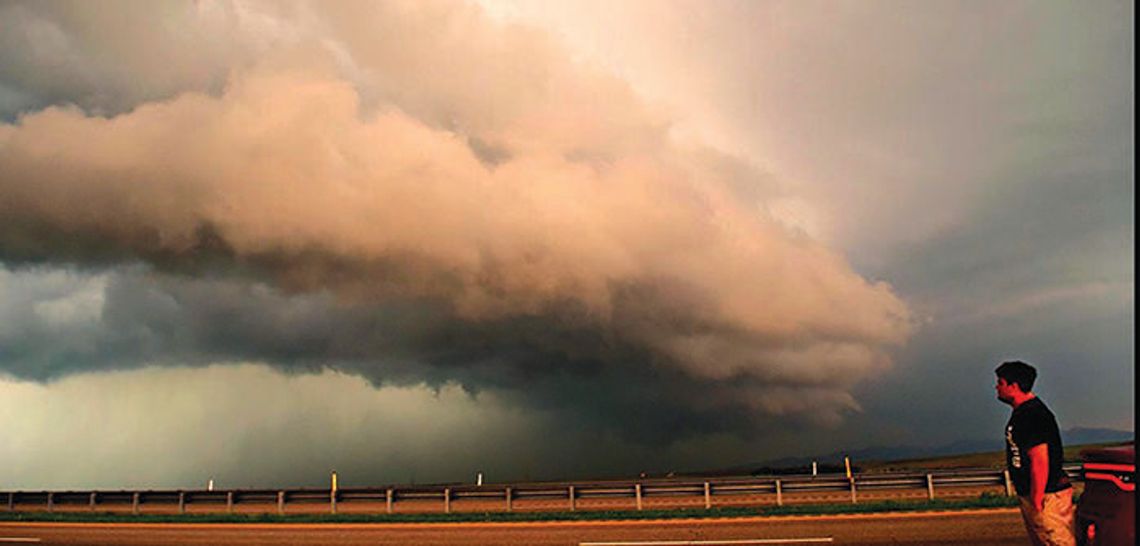[dropcap]S[/dropcap]evere weather was once the stuff of nightmares when Dripping Springs resident Ryan Hearne was growing up.
Such was the case one night in 2010 when a hail-producing storm forced him to the confines of his mother’s closet.
But intrigue about the magnitude of the storm made him overcome his fear – and his future was formed.
“It made me curious about everything that was going on,” Hearne said. “It sparked me because of the immense power I saw and it made me want to learn more about it.”
Over the next few years, Hearne delved deeper into his fascination with severe weather. Eventually, and maybe a bit ironically, the kid who was once scared of weather is, at 18 years old, one of the youngest paid professional tornado storm chasers in the area.
But for Hearne, becoming a storm chaser provides a much deeper responsibility that goes far beyond a simple adrenaline rush.
“We have a huge role in the weather service. We are the eyes on the ground,” Hearne said. “Radar only tells a small story. In the end, tornado reports have to have eyewitnesses. That’s where storm chasers come in.”
Origins with weather
Hearne said interest in weather has gone as far back as when he was six years old. He said his parents knew about his interest because it was all he talked about when he was younger.
In 2010, Hearne began to research weather and how it’s formed. In middle school, he began to analyze storms more extensively using a website called MetEd, which allowed him to take quizzes on weather related information.
By the time he was in 7th grade, Hearne was National Weather Service severe weather spotter certified. The certification is earned after going through a two to three-hour online course and exam on how to spot storms and the science behind meteorology. There are three levels of certification ranging from basic to elite, which equates to college-level meteorology knowledge.
Hearne said it took him six years to obtain elite status.
By 2014, Hearne began to research storm chasing and maps of the state.
The next year, Hearne and a friend began to plan their very first chase.
The first rodeo
But Hearne quickly learned how unprepared he was – to the point that he characterizes his first storm chasing attempt as a “nightmare”.
Both Hearne and his friend traveled to Waco to wait out a storm that had begun forming near Stephenville.
Hearne had access to radar to help chase the storm, but soon realized data is a storm chaser’s best friend.
It didn’t take long for Hearne to run out of data and, subsequently, radar.
“Radar is the most important part of storm chasing,” Hearne said. “If you don’t have radar, you’re flying blind.”
Despite anxieties, Hearne and his friend continued on and eventually traveled toward Stephenville. In Stephenville, Hearne met up and talked with a group of storm chasers.
He eventually traveled with them and soon saw the storm come over a field that “almost looked like an (alien) mothership.”
The group rapidly changed direction, almost hitting each other in the process, to chase a tornado that touched down near Stephenville, Hearne said.
He followed and eventually witnessed an enhanced Fujita (EF) 3 tornado.
“It’s hard to explain the feeling (of seeing a tornado) because your adrenaline is so high,” Hearne said.
The dangers of the business
Since then, Hearne has chased numerous storms and has seen at least five tornadoes in the process.
Only in the past two years has Hearne put more time to a craft that takes “thousands of hours” to perfect and work with.
It’s also an expensive craft, he said. Hearne has retrofitted his red Dodge Dart with hail guards, a “necessary” item, and a “Meso Dome,” which is a 360-degree camera that allows him to record and live stream the action. Not included is the cost of gas, hotels, food and other items during the course of a chase.
Hearne is currently part of a group called SVL Media, which records footage from chases and sells it to television media.
But Hearne said the profession isn’t as dangerous as many believe. It all depends on the experience level of the chaser.
As an experienced chaser, Hearne spends at least two weeks planning his chases, which involves looking at numerous prediction models.
A tornado’s slow trajectory once on the ground is also easy for experienced storm chasers to follow.
But weather also has a knack for being rather unpredictable. As such, weather related dangers, such as hail larger than softballs, high winds and cloud-to-ground lightning, are common.
“This isn’t something you can learn in a year. There are people who have been chasing for 30-plus years and they still don’t have a grasp on this.”
Ryan Hearne, storm chaser
Not-so-obvious dangers include hydroplaning off the road, flat tires, engine failure and other drivers.
Helping is a tight-knit community of fellow storm chasers hailing from around the world that is connected through the bond of metorology.
“When you’re out there chasing, you put your judgments aside,” he said. “The only thing that matters is that storm.”










